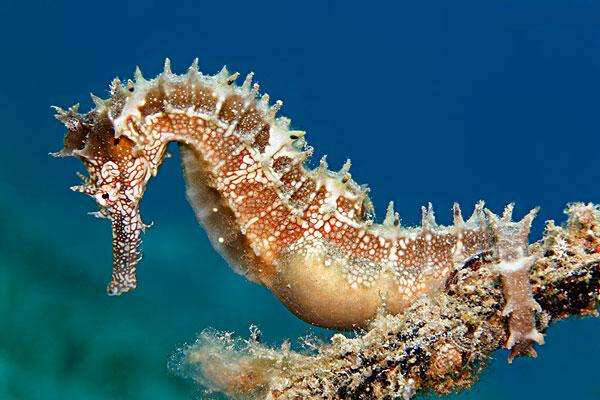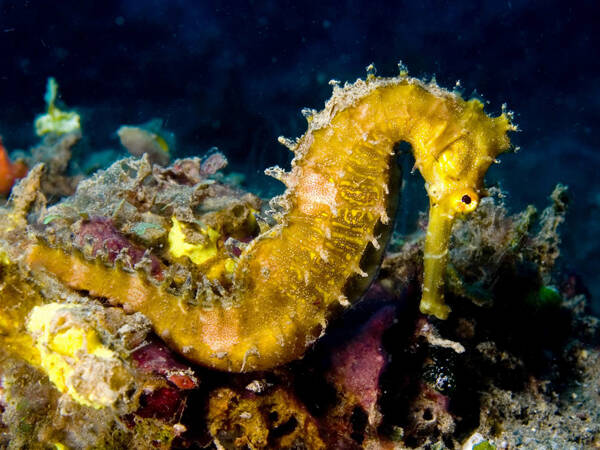Thorny Seahorse (scientific name: Hippocampus histrix) is a member of the Syngnathidae family and the genus Hippocampus. It is a warm-water fish that lives in coastal waters. It inhabits low-tide areas with clear water and lush algae in coastal bays.

The spiny seahorse wraps its curled tail around Zona algae or other seaweeds. Its body color changes with the environment, using protective coloration and mimicry to defend against enemies and lure bait. It swims slowly, sometimes swimming upright. It likes to eat live bait, sucking in planktonic crustaceans such as short-legged lobsters, copepods, mysid shrimp, hair shrimp, krill, and firefly shrimp with its mouth.
The spiny seahorse is ovoviviparous. The male has a brood pouch where the fertilized eggs develop into baby seahorses. The life span is 2 years.
So far (2017), no surveys or population estimates have been conducted specifically for the spiny seahorse. There is little information on its population trends, but based on fisherman interviews and habitat loss (degradation) data, it can be inferred that the population of the spiny seahorse is decreasing (2017).
The whole fish of the spiny seahorse can be dried and used as medicine, which has the effects of warming the kidney and strengthening yang, dispersing stagnation and reducing swelling, relieving cough and asthma, calming the nerves, and relaxing muscles and activating collaterals. Mainly used for treating impotence and infertility, enuresis, asthma due to kidney deficiency, insomnia, mental fatigue due to physical weakness in the elderly, neurasthenia, accumulation of symptoms, injuries due to falls, traumatic bleeding, blood and qi diseases, lymph node tuberculosis, tuberculous fistula, stomach disease, nephritis, back and leg pain, mastitis, abdominal pain, difficult labor in women, carbuncle, furuncle.

The spiny seahorse contains protein, fat, and a variety of amino acids. The yellow pigment of the skin is y-carotene, the red pigment is astaxanthin and schizontine, and the black pigment is melanin. It also contains acetylcholinesterase, cholinesterase, protease, stearic acid cholesterol, 2-hydroxy-4-methoxy-acetophenone, cholesterol, and cholester-5-ene-3β,7αdiol. The protein content is 67.9-73.56%. Its hydrolyzed amino acid content is high, totaling 59.85-65.82%. Of the 17 amino acids contained, 7 are essential amino acids for the human body, accounting for about 30% of the total amino acids. Live seahorses can be used for aquarium trade.
In some areas, fishermen and traders report that the supply of seahorses has declined. For example, in Malaysia and Thailand in 1998 and 1999, surveys of fishermen and traders reported that the supply of seahorses, including seahorses, had fallen by 68±24% over 12 years (a few fishermen reported that the situation was stable). There are also reports that the number of seahorses in the Philippines has declined severely since the 1970s (O'Donnell et al. 2010). In East Africa, surveys of fishers and traders in 2000 documented a decline in the availability and size of seahorses over the past 20 years, including the spiny seahorse (2004). The population decline of the spiny seahorse is likely global, as declines have been reported in several different areas of its range. Conservative estimates put the decline at least 30% over the past decade, and this decline is expected to continue into the future, a rate lower than reported by most fishers (2017).
The main threat to the spiny seahorse is overfishing; its coastal seagrass and coral habitats are also at great risk from eutrophication, sedimentation, coastal construction, dredging, trawling and destructive fishing practices such as dynamite use, and climate change throughout its global distribution. The life history and ecological characteristics of the spiny seahorse may increase its susceptibility to these threats.
Listed in the IUCN Red List of Threatened Species (IUCN 2017 ver 3.1) - Vulnerable (VU).
Listed in the Washington Convention (CITES) - Appendix II.
Listed in the China Species Red List - Endangered Species.
Protect wild animals and eliminate game.
Maintaining ecological balance is everyone's responsibility!